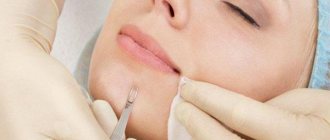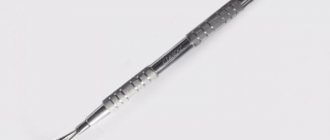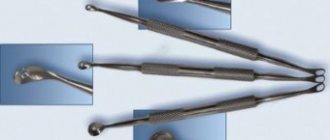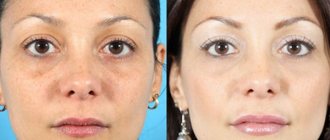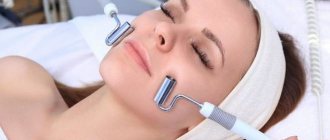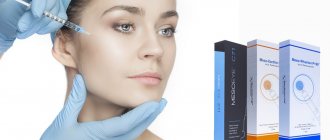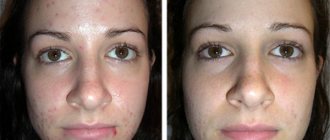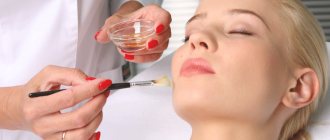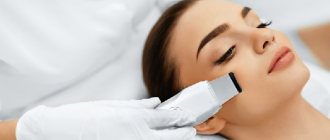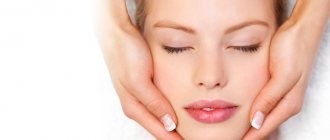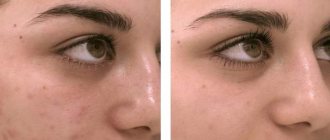In the article “Ultrasonic cleaning of the face, or your pockets?” I told you that ultrasound cleaning, unfortunately, does not remove dense, deep-seated comedones. Such contaminants can only be removed using mechanical or combined cleaning.
- What is mechanical facial cleansing
- Combined facial cleansing
7 popular misconceptions about mechanical facial cleansing
- Mechanical cleaning should be done regularly
- Remove many comedones at once
- Removing inflamed acne
- Steaming your face before cleansing
- Cleaning on the eve of critical days
- Red spots after facial cleansing
- There is no need for facial cleansing at all
I recorded a video for you about mechanical facial cleansing:
About mechanical cleaning
The most popular skin cleansing methods are mechanical, ultrasonic, laser, atraumatic and mixed. They are different, but they are united by one goal - to clear clogged pores of dirt and dead cells.
The essence of mechanical cleansing is to use special objects and hands to remove closed and open comedones and pus from sebaceous plugs that were once affected by inflammation.
Tools:
- Spoon Uno. Using one or more holes made in a metal spoon, single pimples and areas with clogged pores are removed;
- Vidal loop. If there is a deep comedone in the center of the loop, then from gradual pressure on the skin it will come out;
- Vidal's needle. The abscesses are punctured, and then the pus is “pushed out” with a Vidal loop.
These are the most commonly used tools for mechanical cleaning. A good device can be purchased at a professional cosmetology store; it should always be disinfected before and after use.
Do not try to squeeze dirt out of the skin yourself if you do not know the basics of handling the tool!
Below is a video that describes general information about such cleaning:
It can remove existing contaminants, but it does not work well as a preventive measure against inflammation. The main cause of acne, excessive production of androgens, cannot be removed by any cosmetic procedure.
Features of manual cleaning
Cleansing the skin using cosmetics alone cannot remove deep impurities. More radical measures will help eliminate the consequences of the active work of the sebaceous glands.
Manual facial cleansing is an effective procedure that is carried out to cleanse the skin of comedones and acne. Its principle is the mechanical elimination of acne and blackheads by squeezing.
How is mechanical facial cleansing performed and what is it? Manual cleansing of the face from acne and blackheads can be carried out with special tools (Uno spoon, Vidal needle). The technique of manual facial cleansing does not involve any difficulties, but this method is considered a real savior for those who suffer from oily and problematic skin. The procedure itself causes pain and, if not performed correctly, can injure the skin. To ensure that the procedure does not cause complications and does not provoke the appearance of more skin rashes as a result of infection, special attention during the procedure should be paid to disinfecting instruments and treating hands with antiseptic agents.
Before cleaning, the skin is steamed to open the pores and soften the stratum corneum. Thanks to this, contaminants can be easily removed from the pores using tools. After completing this procedure, the face is treated with a disinfectant solution.
Does cleansing your face help with acne and can you do it yourself? Of course, you can clean your face at home if you strictly follow all the recommendations and carry it out under completely sterile conditions.
It is important to follow the rules of facial cleansing at home
Manual facial cleansing is indicated for those who need deep cleansing of the skin and in the presence of deep-lying contaminants that cannot be removed by hardware methods.
Manual facial cleansing is effective for:
- black spots;
- white dots;
- active work of the sebaceous glands;
- acne.
There are contraindications for clearing acne from the skin in this way. You should avoid it if:
- inflammatory processes on the skin;
- purulent neoplasms, herpes;
- rosacea;
- fragility of blood vessels;
- demodicosis;
- furunculosis;
- advanced forms of acne;
- chronic skin diseases;
- dehydrated skin;
- blood diseases;
- bronchial asthma;
- somatic diseases.
It is not recommended to resort to manual cleaning during menstruation. It is also contraindicated for people with a low pain threshold.
Indications and contraindications
You can go for mechanical cleaning if:
- You have oily, combination skin
- You have dry/sensitive/dehydrated skin with impurities (with caution)
- There are open/closed comedones and pus from subsided inflammation on the face
This procedure is contraindicated for you if:
- There is active herpes on the skin
- You are sick with bronchial asthma, hypertension, furunculosis, dermatitis or eczema
- Menstruation on the eve/day of cleansing can reduce the quality of cleansing or lead to complications.
Any mechanical impact on the skin can negatively affect its integrity in the future. It's likely that your "clogged pores" are just Sebaceous Filaments - formations that resemble comedones, although in fact they are a common occurrence of healthy, dense skin.
Progress
In the case where the pores were opened using a special gel, the cosmetologist slightly opens the edges of the film and begins to press blackheads on a small area. First, he uses a spoon of Uno to remove greasy deposits. It is important not to touch areas where there is inflammation or immature acne.
The instrument must be disinfected at certain intervals, for which you can use 3 percent hydrogen peroxide or another disinfectant.
All movements with a spoon are carried out strictly in the opposite direction of the exit of the sebaceous ducts. In other words, when treating the forehead area, you need to move from bottom to top; if the procedure is performed on the cheeks, then to the center from the outside. The nose is cleaned from the base to the back.
After this treatment, sebaceous plugs are removed using an extractor. This is a small spoon on the opposite side. To perform this task, the tool and loop are positioned so that the black dot is strictly under the hole.
With strong impact, the comedone is squeezed out. In this case, the patient practically does not feel pain.
To eliminate whiteheads, initially a puncture is made parallel to the surface of the skin. After this, the eel is squeezed out.
How often should you cleanse your face?
Homemade facial cleansing with a scrub cannot be an alternative to salon procedures.
In cases where sebaceous plugs cannot be removed with the help of special auxiliary devices, the cosmetologist uses his hands. In some situations, a needle is used to widen the ducts. This stage is painful. However, if the skin is well steamed, there is no need to perform it.
At the end of the procedure, the face should be wiped with an alcohol-based solution.
In general, such manipulation can last from several minutes to an hour. It is important to note that it takes about 20 minutes to close the pores after the gel or steam. Therefore, when choosing a specialist, you need to pay attention to the speed of his work. The faster he performs the procedure, the more effective the final result will be.
Procedure
With the exception of some differences in the cosmetics used and the number of stages, mechanical cleaning in the salon is approximately the same.
Stage 1. Cleansing and preparation
After removing makeup and cleansing the skin with a cleanser, a solution is applied to the face to soften the pores and have an analgesic effect. They put a film on it and wait the allotted time.
Steaming the face before the procedure is extremely undesirable, although for some reason it still remains popular among some “specialists”.
Stage 2 Disinfection and cleaning
After removing the preparatory gel, the skin is sprayed with chlorhexidine or another disinfectant. In order not to “tighten” the sebaceous duct, the cosmetologist should not use alcohol. Next comes cleaning.
Using tools, a specialist wearing gloves and hair removed works on the skin. You may feel slight pain or discomfort, and this is normal. Clots of sebum are removed from the pores, without in any way affecting the inflamed elements.
Stage 3. Consolidate the result
After cleaning the pores, the face is again treated with an antiseptic. Next, you may be given liquid nitrogen or a clay mask to soothe the irritated epidermis. Finally, you will be treated with a nourishing, healing cream. At home, you can use pharmaceutical creams with a similar effect (for example, Panthenol).
Don't expect an immediate effect - all the beauty of skin cleansing in the salon will be noticeable after the redness subsides.
If you have too many sebaceous plugs, then it is better to undergo cleansing in several procedures - this will reduce the risk of skin inflammation. After mechanical cleaning, people may experience irritation for 1-2 days - and this is considered normal. However, if you have persistent bruises, bruises or deep wounds, then the beautician most likely treated your face too roughly.
Mechanical cleaning is not recommended for people with constantly clogged pores more than once a month. No more than once a year for those who have mild pollution or appear extremely rarely.
Advantages and disadvantages
Manual cleaning is one of the most effective methods. It allows you to get rid of deep-seated impurities and tidy up your face.
The main advantages of this method are:
- deep cleansing of the skin, which is possible due to the fact that the sebaceous ducts are freed to the very base;
- normalization of sebum production with regular procedure in clients with combination and oily epidermis;
- smoothing the relief and improving skin tone, improving tone and reducing the number of wrinkles;
- low cost of the procedure in the salon, since it does not require expensive equipment.
Manual cleaning also has its disadvantages, which include:
- the procedure is painful and can cause discomfort, the intensity of which depends on the degree of skill of the cosmetologist;
- cleaning is traumatic to the epidermis, so it can cause redness that does not go away for several days;
- due to poor-quality treatment of the skin with antiseptic drugs, rashes may appear;
- an insufficiently experienced cosmetologist can damage the dermis, which causes swelling, bruising and scars;
- Some clients may develop allergies to the cosmetics used;
- a long rehabilitation period is required after the session.
Photos before and after
Why is it necessary to do facial cleansing?
Acne or comedones appear on the face of most people, especially in cities.
Their appearance is associated with the environment and lifestyle. The sebaceous glands secrete a substance designed to protect the skin from drying out and pollution. During normal functioning of the body, the skin cleanses itself. But under the influence of stress, poor nutrition, and diseases of internal organs, skin regeneration slows down, and the secretion of sebaceous glands, on the contrary, increases. As a result, the sebaceous glands become clogged, stop working normally and blackheads appear.
The use of creams, scrubs, and masks will not give the desired result, since comedones are located quite deep inside the skin. To give the skin elasticity and smoothness, professional facial cleansing is necessary. The cleaning process is not entirely pleasant, but it is a safe and necessary procedure. It is prescribed even to teenagers, which indicates no harm to the skin and the sterility of the process. Now about each type of cleaning in more detail.
Ultrasonic or mechanical cleaning – which is better?
Skin pores can be gently cleaned using ultrasonic waves - this is the essence of ultrasonic cleaning. It is more expensive, but there is less risk of causing serious damage to the face due to the mild hardware impact. Even people with sensitive and dry skin can perform ultrasonic cleaning.
Ultrasonic cleaning, unlike mechanical cleaning, has more serious requirements regarding equipment. The cosmetologist will need an emitter device that will cause wave vibrations without harm to the cells.
Another difference from manual cleansing is that the procedure can be done every 10 days. In this case, the effect will be noticeable on day 3-4, depending on the thinness of the epidermis.
Ultrasonic cleaning is not able to remove deep impurities and comedones, but mechanical cleaning copes with this task very well.
In addition to general cleansing and healing, ultrasonic cleansing can lighten various types of age spots (post-acne, sun spots), slightly smooth out wrinkles, eliminate dead skin cells and generally improve the condition of the skin. It can be combined with mechanical cleansing, but only if the skin has obvious signs of comedones and acne (read more about combined facial cleansing here)
You may be interested in: Facial rejuvenation using ultrasonic cleaning
Folk remedies for clearing acne from skin
If it is not possible to seek help from a cosmetologist, but you need to clear your face of acne and comedones, you can cleanse your face at home.
Using masks has a positive effect on facial skin
To do this, you can use various traditional medicine.
Chamomile mask
A mask based on chamomile, gelatin, and milk will help clear the skin of acne. Place 1 tbsp in a container. l. gelatin and herbs and pour 100 ml of milk. All ingredients must be mixed well and placed in the microwave for 30 seconds. Apply the mixture to your face after cooling. The mask should harden completely. Then you need to wash it off and wipe the skin with lotion.
Care after mechanical cleaning
A qualified cosmetologist should tell you the basics of skin care after mechanical cleansing:
1. It is forbidden to wash your face for 12 hours and scrub your skin in any way;
2. Decorative cosmetics (foundation, concealer and powder) are not allowed to be used for 2 days;
3. Do not peel off the crusts that have formed on the wounds from the skin - this will slow down its healing;
4. The next visit to a cosmetologist associated with aggressive effects on the face can be made no earlier than after 1 month.
Consequences
If during the procedure the cosmetologist violated the technique, or the patient did not adhere to all the necessary instructions, then the development of some complications cannot be ruled out.
Redness
As a rule, this condition is considered normal and goes away on its own after 1-2 days. A more persistent symptom may occur as a result of increased sensitivity or improper cleaning. To eliminate this side effect, it is recommended to make masks with a soothing property or apply cold compresses.
Edema
The swelling also subsides within a couple of days. If this does not happen, you should consult a dermatologist who can determine a more precise cause of this phenomenon.
Hematomas
Bruises can appear as a result of increased exposure of the skin by a specialist or if contraindications are ignored. To eliminate them, you can use heparin ointment.
Inflammation
The inflammatory process may begin to develop two days after the procedure. Among the main reasons are improper care or unprofessionalism of a cosmetologist. In this case, you need to see a doctor who will select the most effective treatment.
Scarring
They may remain as a result of non-compliance with the cleansing manipulation technique. Failure to comply with follow-up care instructions may also be to blame. To eliminate this problem, special additional cosmetic procedures will be needed.
Allergy
Both during and after the session, the occurrence of an allergic reaction cannot be ruled out. For treatment, you need to start taking antihistamine medications.
Infection
It occurs against the background of neglect of the rules of antiseptics and asepsis. To get rid of the problem, you will need to undergo a course of antibacterial therapy.
